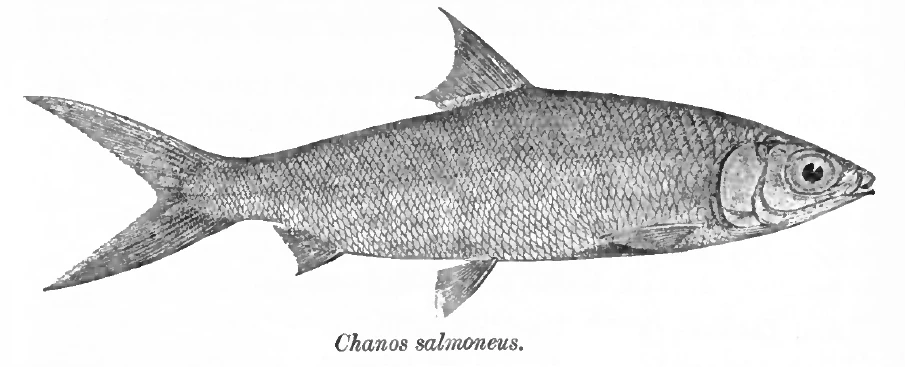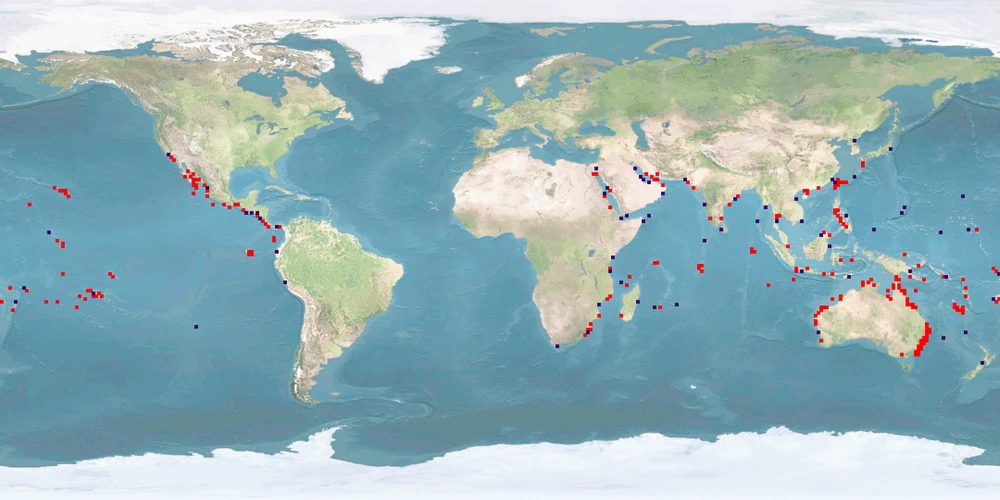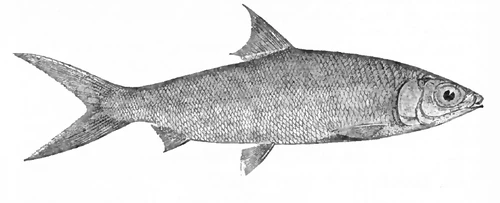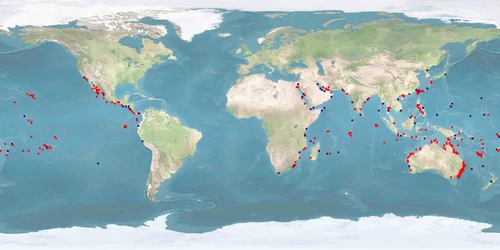Farming remarks
Chanos chanos is a BENTHOPELAGIC Indo-Pacific fish species that is found along continental shelves and around islands of low latitude tropics or in the subtropical northern hemisphere where temperatures are higher than 20 °C. This euryhaline fish can be found in fresh, brackish, and marine waters, occurring in small to large schools near the coasts or around islands where reefs are well developed. It is an AMPHIDROMOUS species: SPAWNERS release eggs in oceanic waters, then older LARVAE migrate onshore and settle in coastal wetlands like mangroves or estuaries (occasionally entering freshwater lakes), and JUVENILES then migrate back to sea where they mature sexually.
C. chanos is especially valued as a food fish in Southeast Asia and also used in game fish as bait. Taiwan, Indonesia, and Philippines – countries that started to culture this fish about 4-6 centuries ago – are the main producers. This fish is tolerant to low concentrations of oxygen and is usually farmed in ponds, pens, or cages in wide salinity ranges. Although being able to spawn naturally in captivity, the traditional farming usually depended on an annual restocking of ponds with FINGERLINGS reared from wild-caught FRY. Now farms are obtaining FRY from hatcheries. C. chanos is harvested and marketed mostly fresh or chilled, whole or deboned, frozen or processed. When harvested, individuals are JUVENILES. Thus, farming information about ADULTS are usually restricted to broodstock. Moreover, further studies about home range, aggression, substrate availability in farms, and stunning and slaughtering protocols are still needed for this species.
For details see: WelfareCheck | farm (latest major release: 2022-05-23)
Related news
Series 8 of our Fish Talk podcast programme on the FishEthoBase just launched. Please find it here. In audio features of less than 3 minutes each, you are invited to learn about Milkfish (Chanos chanos), Channel catfish (Ictalurus punctatus), and Pond loach (Misgurnus anguillicaudatus) and which aspects of their natural needs may or may not be accommodated in captivity. If you would like to dive deeper into our assessments of these species, you will find their profiles in our FishEthoBase.




Probably, we updated the profile. Check the version number in the head of the page. For more information on the version, see the FAQ about this. Why do we update profiles? Not just do we want to include new research that has come out, but we are continuously developing the database itself. For example, we changed the structure of entries in criteria or we added explanations for scores in the WelfareCheck | farm. And we are always refining our scoring rules.
The centre of the Overview is an array of criteria covering basic features and behaviours of the species. Each of this information comes from our literature search on the species. If we researched a full Dossier on the species, probably all criteria in the Overview will be covered and thus filled. This was our way to go when we first set up the database.
Because Dossiers are time consuming to research, we switched to focusing on WelfareChecks. These are much shorter profiles covering just 10 criteria we deemed important when it comes to behaviour and welfare in aquaculture (and lately fisheries, too). Also, WelfareChecks contain the assessment of the welfare potential of a species which has become the main feature of the fair-fish database over time. Because WelfareChecks do not cover as many criteria as a Dossier, we don't have the information to fill all blanks in the Overview, as this information is "not investigated by us yet".
Our long-term goal is to go back to researching Dossiers for all species covered in the fair-fish database once we set up WelfareChecks for each of them. If you would like to support us financially with this, please get in touch at ffdb@fair-fish.net
See the question "What does "not investigated by us yet" mean?". In short, if we have not had a look in the literature - or in other words, if we have not investigated a criterion - we cannot know the data. If we have already checked the literature on a criterion and could not find anything, it is "no data found yet". You spotted a "no data found yet" where you know data exists? Get in touch with us at ffdb@fair-fish.net!
Lorem ipsum
In the fair-fish database, when you have chosen a species (either by searching in the search bar or in the species tree), the landing page is an Overview, introducing the most important information to know about the species that we have come across during our literatures search, including common names, images, distribution, habitat and growth characteristics, swimming aspects, reproduction, social behaviour but also handling details. To dive deeper, visit the Dossier where we collect all available ethological findings (and more) on the most important aspects during the life course, both biologically and concerning the habitat. In contrast to the Overview, we present the findings in more detail citing the scientific references.
Depending on whether the species is farmed or wild caught, you will be interested in different branches of the database.
Farm branch
Founded in 2013, the farm branch of the fair-fish database focuses on farmed aquatic species.
Catch branch
Founded in 2022, the catch branch of the fair-fish database focuses on wild-caught aquatic species.
The heart of the farm branch of the fair-fish database is the welfare assessment – or WelfareCheck | farm – resulting in the WelfareScore | farm for each species. The WelfareCheck | farm is a condensed assessment of the species' likelihood and potential for good welfare in aquaculture, based on welfare-related findings for 10 crucial criteria (home range, depth range, migration, reproduction, aggregation, aggression, substrate, stress, malformations, slaughter).
For those species with a Dossier, we conclude to-be-preferred farming conditions in the Advice | farm. They are not meant to be as detailed as a rearing manual but instead, challenge current farming standards and often take the form of what not to do.
In parallel to farm, the main element of the catch branch of the fair-fish database is the welfare assessment – or WelfareCheck | catch – with the WelfareScore | catch for each species caught with a specific catching method. The WelfareCheck | catch, too, is a condensed assessment of the species' likelihood and potential for good welfare – or better yet avoidance of decrease of good welfare – this time in fisheries. We base this on findings on welfare hazards in 10 steps along the catching process (prospection, setting, catching, emersion, release from gear, bycatch avoidance, sorting, discarding, storing, slaughter).
In contrast to the farm profiles, in the catch branch we assess the welfare separately for each method that the focus species is caught with. In the case of a species exclusively caught with one method, there will be one WelfareCheck, whereas in other species, there will be as many WelfareChecks as there are methods to catch the species with.
Summarising our findings of all WelfareChecks | catch for one species in Advice | catch, we conclude which catching method is the least welfare threatening for this species and which changes to the gear or the catching process will potentially result in improvements of welfare.
Try mousing over the element you are interested in - oftentimes you will find explanations this way. If not, there will be FAQ on many of the sub-pages with answers to questions that apply to the respective sub-page. If your question is not among those, contact us at ffdb@fair-fish.net.
It's right here! We decided to re-name it to fair-fish database for several reasons. The database has grown beyond dealing purely with ethology, more towards welfare in general – and so much more. Also, the partners fair-fish and FishEthoGroup decided to re-organise their partnership. While maintaining our friendship, we also desire for greater independence. So, the name "fair-fish database" establishes it as a fair-fish endeavour.





